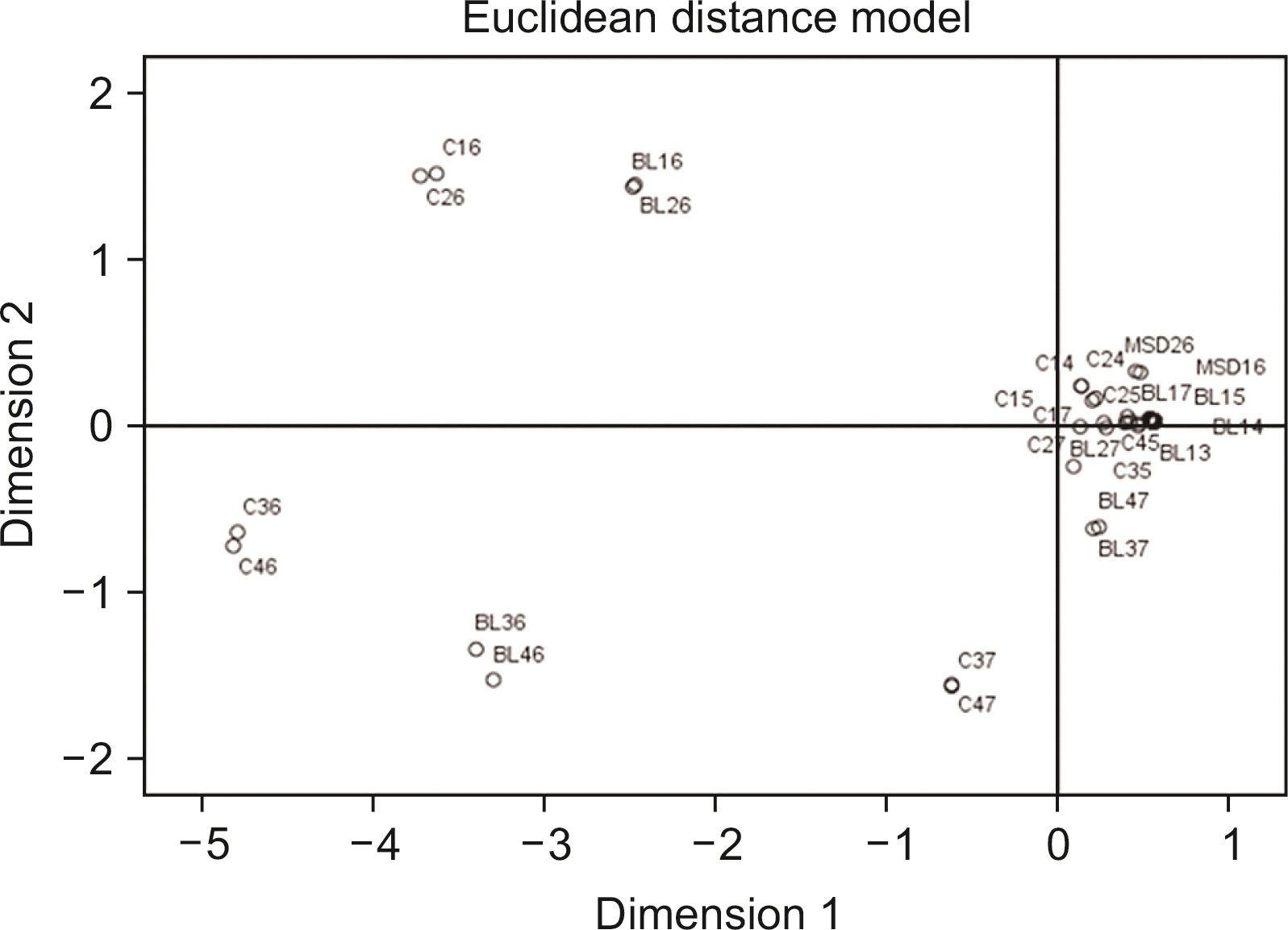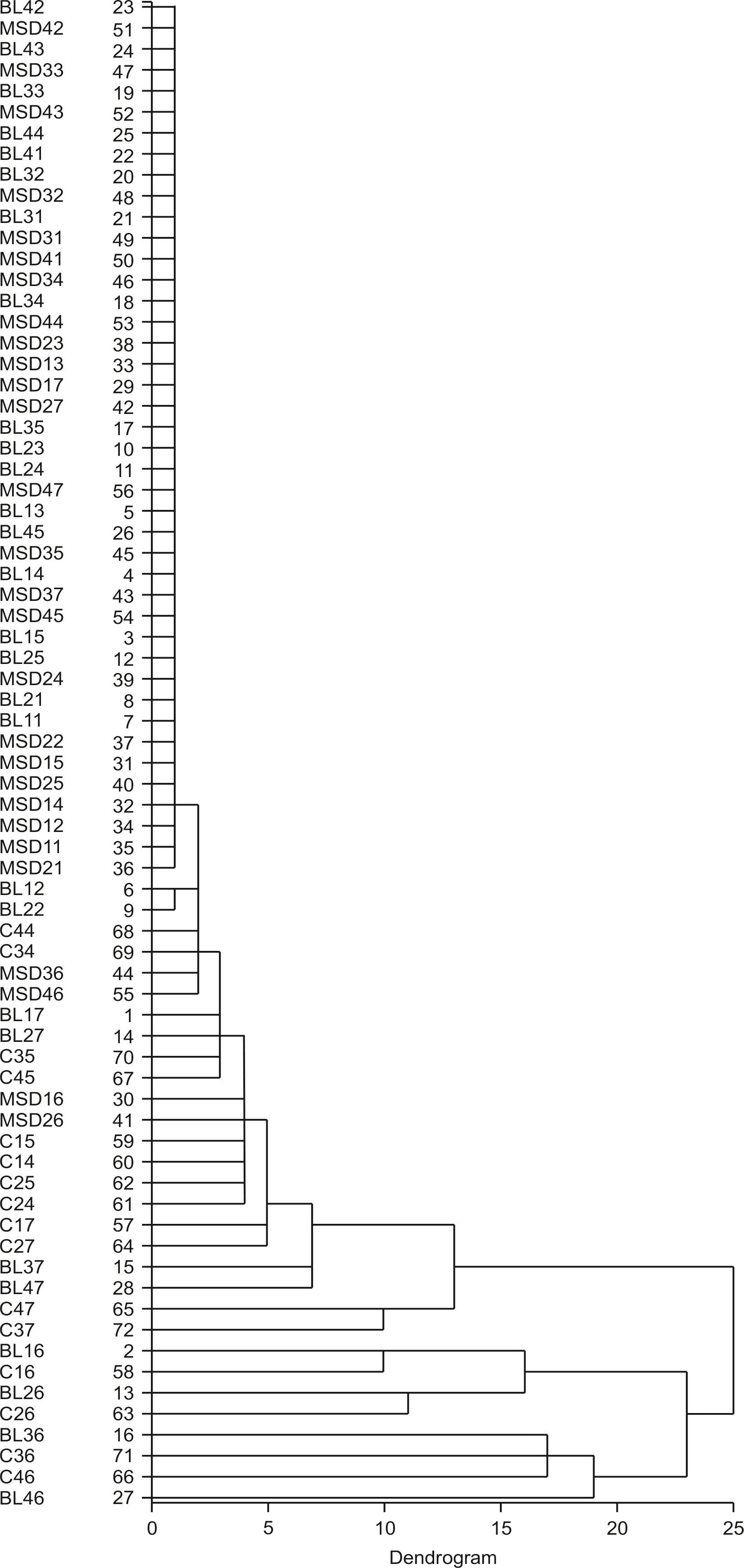J Korean Acad Oral Health.
2023 Sep;47(3):125-131. 10.11149/jkaoh.2023.47.3.125.
Classification of dental caries pattern in 12-year-old Korean adolescents by multivariate analysis
- Affiliations
-
- 1Department of Dental Hygiene, Yeoju Institute of Technology, Yeoju, Korea
- 2Department of Preventive and Public Health Dentistry, College of Dentistry, Institute of BiomaterialsㆍImplant (WBMI) and Institute of Wonkwang Dental Research, Wonkwang University, Iksan, Korea
- KMID: 2546508
- DOI: http://doi.org/10.11149/jkaoh.2023.47.3.125
Abstract
Objectives
The purpose of this study was to analyze the pattern of dental caries in 12-year-old Korean adolescents through multivariate analysis.
Methods
This study used raw data from the 2015 Korea Children’s Oral Health Survey. The study participants were 12-year-old adolescents. A total of 27,291 people participated in the questionnaire and oral test. The statistical analysis methods used were multidimensional scaling, cluster analysis, and factor analysis.
Results
The result was derived after analyzing the dental caries pattern of teeth and tooth surface by multi-dimensional scaling method, cluster analysis method, and factor analysis. Morphologically homologous teeth were gathered to form clusters. Caries occurrence showed a more similar caries experience pattern when the types of tooth surfaces, such as occlusal and occlusal surfaces, were the same than when they were different.
Conclusions
Epidemiological data on the pattern of dental caries in 12-year-old adolescents can be used as basic data to create evidence-based dental caries management plans.
Keyword
Figure
Reference
-
References
1. Lee BG, Lee HS, Ju HJ, Oh HW. 2014; Dental caries pattern in primary dentition among Korean children. J Korea Acad Oral Health. 38:95–104. DOI: 10.11149/jkaoh.2014.38.2.95.2. Batchelor PA, Sheiham A. 2004; Grouping of tooth surfaces by susceptibility to caries: a study in 5-16 year-old children. BMC Oral Health. 4:2. DOI: 10.1186/1472-6831-4-2. PMID: 15511295. PMCID: PMC526778. PMID: a5dedcfc3b2e43429a47a7a5a97c4c9c.3. Shaffer JR, Feingold E, Wang X, Tcuenco K, Weeks DE, DeSensi RS, Polk DE, Wendell S, Weyant RJ, Crout R, McNeil DW, Maraztia ML. 2012; Heritable patterns of tooth decay in the permanent dentition: principal components and factor analyses. BMC Oral Health. 12:7. DOI: 10.1186/1472-6831-12-7. PMID: 22405185. PMCID: PMC3328249. PMID: b738813eaf9b4531953d0be3b6f14275.4. Psoter WJ, Zhang H, Pendrys DG, Morse DE, Mayne ST. 2003; Classification of dental caries patterns in the primary dentition: a multidimensional scaling analysis. Community Dent Oral Epidemiol. 31:231–238. DOI: 10.1034/j.1600-0528.2003.00044.x. PMID: 12752550.5. Lee JS, Lee KH, Kim DE. 1999; Caries patterns in primary dentition by caries experience of individual teeth. J Korean Acad Pediatr Dent. 26:1–13.6. Psoter WJ, Pendrys DG, Morse DE, Zhang HP, Mayne ST. 2009; Caries patterns in the primary dentition: cluster analysis of a sample of 5169 Arizona children 5-59 months of age. Int J Oral Sci. 1:189–195. DOI: 10.4248/IJOS09077. PMID: 20690422. PMCID: PMC3733597.7. Shaffer JR, Feingold E, Wang X, Weeks DE, Weyant RJ, Crout R, et al. 2013; Clustering tooth surfaces into biologically informative caries outcomes. J Dent Res. 92:32–37. DOI: 10.1177/0022034512463241. PMID: 23064960. PMCID: PMC3521447.8. Jeong SY, Lee KH, Ra JY, An SY, Kim YH. 2010; Dental caries patterns in the primary dentition: a cluster analysis and a multidimensional scaling analysis. J Korean Acad Pediatr Dent. 37:159–167.9. Jung SH, Ju HJ, Lee HS. 2015; Dental caries experience pattern in permanent dentition among Korean adolescents. J Korea Acad Oral Health. 39:134–144. DOI: 10.11149/jkaoh.2015.39.2.134.10. Kim IJ, Ju HJ, Lee SH, Lee HS. 2015; Pattern of dental caries experience on tooth surface in Korean adolescents. J Korea Acad Oral Health. 39:251–258. DOI: 10.11149/jkaoh.2015.39.4.251.11. Kim IJ, Ju HJ, Lee SH, Na JY, Oh HW, Lee HS. 2016; Pattern of dental caries in Korean adolescents with a high risk of caries. J Korea Acad Oral Health. 40:126–132. DOI: 10.11149/jkaoh.2016.40.2.126.12. Gisselsson H, Birkhed D, Björn AL. 1994; Effect of a 3-year professional flossing program with chlorhexidine gel on approximal caries and cost of treatment in preschool children. Caries Res. 28:394–399. DOI: 10.1159/000262008. PMID: 8001065.13. Gisselsson H, Birkhed D, Emilson CG. 1999; Effect of professional flossing with NaF or SnF2 gel on approximal caries in 13-16-year-old schoolchildren. Acta Odontol Scand. 57:121–125. DOI: 10.1080/000163599429020. PMID: 10445367.14. Lee BH, Shin SC. 1994; A Study on the estimation of emergence timing and emergence sequence of permanent teeth in Korean children for the preventive care. J Korea Acad Oral Health. 18:458–485.15. Armfield JM, Spencer AJ. 2007; Community effectiveness of fissure sealants and the effect of fluoridated water consumption. Community Dent Health. 24:4–11. PMID: 17405464.16. Ahn SH, You HY, Kim MJ, Han DH, Kim JB, Jeong SH. 2012; Caries pre- ventive effect of permanent teeth using pit and fissure sealant program and community water fluoridation program. J Korea Acad Oral Health. 36:289–296. DOI: 10.11149/jkaoh.2012.36.4.289.
- Full Text Links
- Actions
-
Cited
- CITED
-
- Close
- Share
- Similar articles
-
- Pattern of dental caries in Korean adolescents with a high risk of caries
- Dental caries experience pattern in permanent dentition among Korean adolescents
- Patterns of dental caries experience on tooth surface in Korean adolescents
- Dental caries incidence in permanent teeth of 12-year-old children in Korea
- Trends of Dental Caries Prevalence in Children Under 14-Year-Old Using a Health Insurance Database





